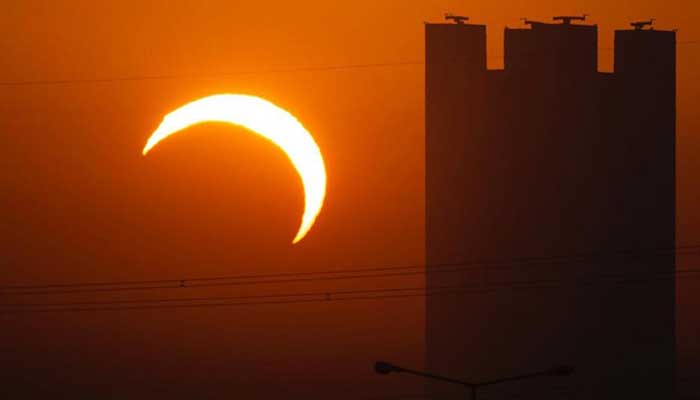Suraj grahan on April 20: Will solar eclipse be visible in Pakistan?
World is set to witness the first solar eclipse of 2023 tomorrow (April 20), which may also be hybrid solar eclipse
The first solar eclipse of the year 2023 will be witnessed in some parts of the globe tomorrow (April 20). The phenomenon is likely to offer a breathtaking sight to the world as it may also be a hybrid solar eclipse.
However, will the space activity be visible in Pakistan or not?
Eclipses are rare occurrences that take place when the moon sun and earth align in a cosmic setting casting their shadow or blocking the sunlight. However, the phenomenon of hybrid solar eclipses is extremely unusual, which occurs just a few times in a century.
The hybrid solar eclipse shifts to an annular (ring-shaped) from a total solar eclipse as the shadow of the moon falls on the Earth.
Pakistan Meteorological Department (PMD) had confirmed that the phenomenon is going to take place.
A brief statement by the PMD said that the eclipse will start early morning and end right before noon on April 20 as per Pakistan standard time, but it will not be visible anywhere in the country.
The timings for the different phases of solar eclipse are given below:
- Eclipse begins at 6:34am (PST)
- Total eclipse will occur at 7:37am (PST)
- Eclipse will peak at 9:17am (PST)
- Ends at 11:59am (PST)
As per the PMD, some parts of the world will witness the rare solar eclipse partially and some completely. The phenomenon will be visible from parts of southern and eastern Asia, Australia and Antarctica, and over the Indian Ocean and the Pacific Ocean.
April has been designated as "Global Astronomy Month" by a US-based organisation Astronomers Without Borders, as the month will offer mesmerising sights in the sky, as per the report by Popular Science.
The April 20 solar eclipse will create a ring of fire which will be witnessed for a brief time in the Indian Ocean but the moon will be covering the sun completely when it reaches Western Australia witnessing around nine minutes of darkness during the day.
However, this solar eclipse will not be visible in the US but just after a few months in October, there will be another solar eclipse which will be seen in the western part of the US.
-
Security forces gun down 30 terrorists in multiple IBOs in KP: ISPR
-
MQM-P calls for new province in Sindh
-
US report validates Pakistan military edge over India: PM
-
Banned TTP poses serious threat to Pakistan security: UNSC panel
-
CM Afridi clarifies remarks on by-poll after ECP requests army deployment
-
Dubai sees 3.2m Pakistani passengers in 2025 as airport sets new milestone
-
Security forces kill 23 Indian proxy terrorists in KP's Kurram
-
Pakistan to construct island to boost oil exploration: report












